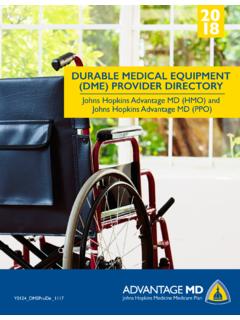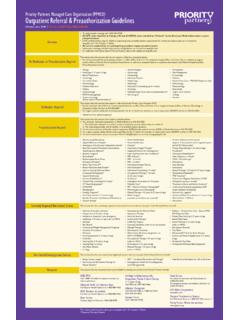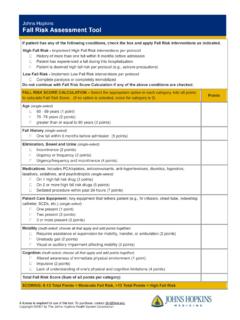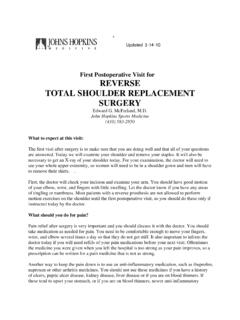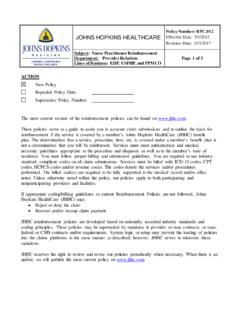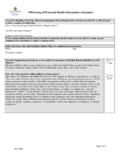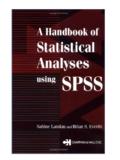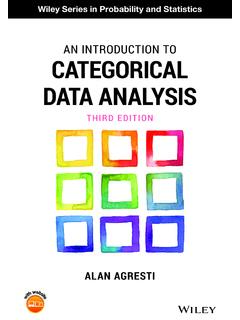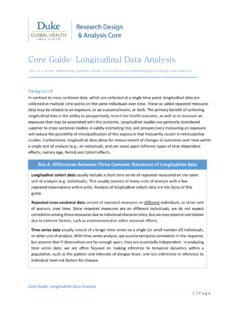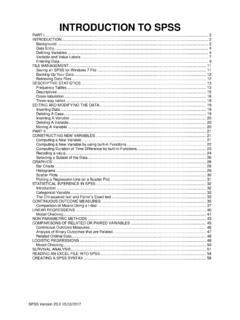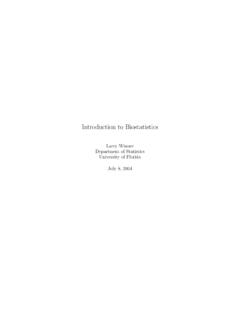Transcription of Epidemiologic Study Designs - Hopkins Medicine
1 Epidemiologic Study Designs Jacky M Jennings, PhD, MPH Associate Professor Associate Director, General Pediatrics and Adolescent Medicine Director, Center for Child & Community Health Research (CCHR) Departments of Pediatrics & Epidemiology Johns Hopkins University Learning Objectives Identify basic Epidemiologic Study Designs and their frequent sequence of Study Recognize the basic components Understand the advantages and disadvantages Appropriately select a Study design Research Question & Hypotheses Study Design Analytic Plan Basic Study Designs and their Hierarchy Systematic Review Randomized Controlled Trial Cohort Study Case-Control Study Descriptive Study Clinical Observation Adapted from Gordis, 1996 Hypothesis Causality MMWR Study Design in Epidemiology Depends on: The research question and hypotheses Resources and time available for the Study Type of outcome of interest Type of exposure of interest Ethics Study Design in Epidemiology Includes.
2 The research question and hypotheses Measures and data quality Time Study population Inclusion/exclusion criteria Internal/external validity Epidemiologic Study Designs Descriptive studies Seeks to measure the frequency of disease and/or collect descriptive data on risk factors Analytic studies Tests a causal hypothesis about the etiology of disease Experimental studies Compares, for example, treatments Cross-sectional Case-Control Cohort TIME EXPOSURE OUTCOME OUTCOME EXPOSURE EXPOSURE OUTCOME Cross-sectional studies Measure existing disease and current exposure levels at one point in time Sample without knowledge of exposure or disease Ex. Prevalence studies Cross-sectional studies Advantages Often early Study design in a line of investigation Good for hypothesis generation Relatively easy, quick and on question Examine multiple exposures or outcomes Estimate prevalence of disease and exposures Cross-sectional studies Disadvantages Cannot infer causality Prevalent vs.
3 Incident disease May miss latent disease May be subject to recall bias Research Question Determine whether there are differences in rates of stroke and myocardial infarction by gender and race among patients. Hypothesis There will be differences in rates of stroke by gender and race. There will be differences in rates of myocardial infarction by gender and race. Case-Control studies Identify individuals with existing disease/s and retrospectively measure exposure Population Cases Controls Exposed Not exposed Exposed Not exposed Time Case-Control studies Advantages Good design for rare, chronic and long latency diseases Relatively inexpensive (population size and time) Allows for the examination of multiple exposures Estimate odds ratios Hospital-based studies and outbreaks Case-Control studies Disadvantages Multiple outcomes cannot be studied Recall bias Sampling bias Cannot calculate prevalence, incidence, population relative risk or attributable risk Beware of reverse causation Neonatal Abstinence Syndrome (NAS) and Drug Exposure Research question ?
4 Hypothesis 1 Buprenorphine-exposed neonates will exhibit less NAS than methadone-exposed neonates. Case-Control Study Example Hypothesis 1: Buprenorphine-exposed neonates will exhibit less NAS than methadone-exposed neonates. Neonates NAS Non-NAS Metha-done Metha-done Bupren- orphine Bupren- orphine Challenges in Case-Control Studies Selection of Controls Sample size Matching (group or individual) Selection of Cases Incident or prevalent disease Nested case-control Study Cohort Studies Population Unexposed Exposed No disease Disease No disease Disease Time Identify exposed and unexposed individuals and follow them over time measuring outcome/s (Prospective) Prospective Cohort Study Study starts exposure disease Time Time exposure Study starts disease Retrospective Cohort Study exposure disease Study starts Time Cohort Studies Advantages Measure population-based incidence Relative risk and risk ratio estimations Rare exposures Temporality Less likely to be subject to biases (recall and selection as compared to Case-control)
5 Possible to assess multiple exposures and/or outcomes Cohort Studies Disadvantages Impractical for rare diseases and diseases with a long latency Expensive Often large Study populations Time of follow-up Biases Design - sampling, ascertainment and observer Study population non-response, migration and loss-to-follow-up Research Question Determine whether circulating biomarkers ( C-reactive protein; exhaled breath condensate - pH, hydrogen peroxide, 8-isoprostene, nitrite, nitrate levels; sputum - TNF- , IL-6, IL-8, IL-1 , neutrophil elastase; and fractional exhaled nitric oxide) predict individuals who will benefit from initiation of antibiotic therapy for the treatment of a mild decrease in FEV1. Hypothesis Biomarkers at the time of presentation with a mild increase in pulmonary symptoms or small decline in FEV1 can be used to identify which patients require antibiotics to recover.
6 Individuals with exacerbation with cystic fibrosis (CF) No-biomarker biomarkers No response Response to antibiotic therapy Baseline days weeks Cohort Study Important features How much selection bias was present? Were only people at risk of the outcome included? Was the exposure clear, specific and measureable? Were the exposed and unexposed similar in all important respects except for the exposure? Were steps taken to minimize information bias? Was the outcome clear, specific and measureable? Was the outcome identified in the same way for both groups? Was the determination of the outcome made by an observer blinded to treatment? Important features How complete were the follow-up of both groups? What efforts were made to limit loss to follow-up? Was loss to follow-up similar in both groups?
7 Were potential confounding factors sought and controlled for in the Study design or analysis? Did the investigators anticipate and gather information on potential confounding factors? What methods were used to assess and control for confounding? Randomized Controlled Trials (RCTs) Experimental: exposure is assigned Randomization assignment Random allocation of exposure or treatment Results (or should result!) in two equivalent groups on all measured and unmeasured confounders Gold Standard for causal inference Randomized Controlled Trials Advantages Least subject to biases of all Study Designs (IF designed and implemented !) Randomized Controlled Trials Disadvantages Intent-to-treat Loss-to-follow-up Randomization issues Not all exposures can be treatments , are assignable Note: for reporting of RCTs see Altman DG, et al.
8 CONSORT GROUP (Consolidated Standards of Reporting Trials). Ann Intern Med. 2001 Apr 17;134(8):663-94. Research Question To determine whether resident s attitudes and skills in diabetes management and counseling change after a curricular intervention. To determine whether patient outcomes related to diabetes ( weight, smoking status) change after a curricular intervention among residents. Hypothesis Attitudes and skills related to diabetes management and counseling will improve among residents after a curricular intervention. Fewer patients with diabetes will smoke over time after a curricular intervention among residents. Randomization Strategies Randomly assigned Quasi-randomization Block randomization method of randomization that ensures that at any point in the trial, roughly equal numbers of participants have been allocated to the comparison groups Grimes & Schulz, 2002 Study Design Must be defensible Drives conclusions: What do you want to be able to say at the end of the Study ?
9 Exploratory data Analyses Jacky M Jennings, PhD, MPH Objectives To identify some basic steps in data analyses To understand the reason for and methods of exploratory quantitative data analysis To learn some statistical tools for inferential statistics Research Questions Testable hypotheses Measureable exposure and outcome Time - how is time incorporated Study population Taking Stock of your data How was the data measured? Type of data ( continuous, dichotomous, categorical , etc.) Single item, multiple items, new/previously validated measure Cross-sectional vs. cohort Study ( one measure in time vs. multiple measures over time) Descriptive Statistics Exploratory data analysis (EDA) Basic numerical summaries of data ( Table 1 in a paper) Basic graphical summaries of data Goal: to visualize relationships and generate hypotheses Basis of Statistics Exploratory data Analysis (EDA) Essential first step of data analysis Helps to: Identify errors Visualize distributions and relationships See patterns, natural or unnatural Find violations of statistical assumptions Generate hypotheses Look Total 42 42 42 42 42 210.
10 10 4 4 7 10 35 0 0 1 0 0 1 0 0 0 0 1 1 .985 0 1 0 0 0 1 .904 0 1 0 0 0 1 .651 0 0 1 0 0 1 .574 0 0 1 0 0 1 .566 0 0 1 0 0 1 .35 0 0 0 0 1 1 .328 0 0 0 1 0 1 .303 0 0 0 1 0 1.
